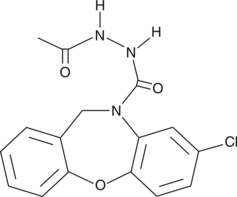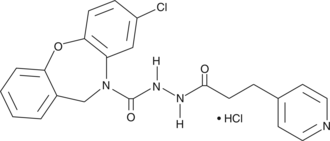Cayman
Showing 39001–39150 of 45550 results
-
SBE 13 is a potent inhibitor of polo-like kinase 1 (Plk1) (IC50 = 0.2 nM) that targets the inactive conformation of the enzyme {33293,33294}. It exhibits no activity against aurora A kinase and less effectively inhibits Plk2 (IC50 > 66 µM) and Plk3 (IC50 = 875 nM). SBE 13 induces cell cycle arrest, reduces cell proliferation (EC50 = 5-60 µM), and induces apoptosis in a broad range of human cancer cell lines.{33294,33295}
Brand:CaymanSKU:21241 -Out of stock
SBE 13 is a potent inhibitor of polo-like kinase 1 (Plk1) (IC50 = 0.2 nM) that targets the inactive conformation of the enzyme {33293,33294}. It exhibits no activity against aurora A kinase and less effectively inhibits Plk2 (IC50 > 66 µM) and Plk3 (IC50 = 875 nM). SBE 13 induces cell cycle arrest, reduces cell proliferation (EC50 = 5-60 µM), and induces apoptosis in a broad range of human cancer cell lines.{33294,33295}
Brand:CaymanSKU:21241 -Out of stock
SBE 13 is a potent inhibitor of polo-like kinase 1 (Plk1) (IC50 = 0.2 nM) that targets the inactive conformation of the enzyme {33293,33294}. It exhibits no activity against aurora A kinase and less effectively inhibits Plk2 (IC50 > 66 µM) and Plk3 (IC50 = 875 nM). SBE 13 induces cell cycle arrest, reduces cell proliferation (EC50 = 5-60 µM), and induces apoptosis in a broad range of human cancer cell lines.{33294,33295}
Brand:CaymanSKU:21241 -Out of stock
SBFI AM is a membrane-permeant, fluorescent Na+ indicator dye. It is selective for Na+ over K+ with Kd values of 20 and 120 mM for these ions, respectively.{30208} Increasing concentration of Na+ increases the ratio of excitation efficiency at 330-345 nm to that at 370-390 nm with emission collected at 450-550 nm.{30208} Therefore, ratio fluorometry and imaging can be performed with the same wavelengths. SBF AM is suitable for single intracellular dye injection and is typically used for high-resolution measurements of Na+ concentration in intact tissue through two-photon confocal imaging.{30207}
Brand:CaymanSKU:-Available on backorder
ULK1 is a serine/threonine kinase that acts upstream of phosphatidylinositol 3-kinase (PI3K) to regulate the formation of autophagophores, the precursors of autophagosomes, in response to nutrient deprivation. It is activated by phosphorylation by AMPK and, in turn, phosphorylates and inhibits AMPK. SBI-0206965 is an inhibitor of ULK1 (IC50 = 108 nM) that is less effective against ULK2 (IC50 = 711 nM).{29597} It is selective for ULK1 and ULK2 over a panel of 456 additional kinases, showing activity against a few kinases in vitro but not in cells.{29597} SBI-0206965 suppresses autophagy induced by mTOR inhibition via AZD 8055 (Item No. 16978). It also blocks ULK1-dependent cell survival following nutrient deprivation.{29597}
Brand:CaymanSKU:-Available on backorder
ULK1 is a serine/threonine kinase that acts upstream of phosphatidylinositol 3-kinase (PI3K) to regulate the formation of autophagophores, the precursors of autophagosomes, in response to nutrient deprivation. It is activated by phosphorylation by AMPK and, in turn, phosphorylates and inhibits AMPK. SBI-0206965 is an inhibitor of ULK1 (IC50 = 108 nM) that is less effective against ULK2 (IC50 = 711 nM).{29597} It is selective for ULK1 and ULK2 over a panel of 456 additional kinases, showing activity against a few kinases in vitro but not in cells.{29597} SBI-0206965 suppresses autophagy induced by mTOR inhibition via AZD 8055 (Item No. 16978). It also blocks ULK1-dependent cell survival following nutrient deprivation.{29597}
Brand:CaymanSKU:-Available on backorder
ULK1 is a serine/threonine kinase that acts upstream of phosphatidylinositol 3-kinase (PI3K) to regulate the formation of autophagophores, the precursors of autophagosomes, in response to nutrient deprivation. It is activated by phosphorylation by AMPK and, in turn, phosphorylates and inhibits AMPK. SBI-0206965 is an inhibitor of ULK1 (IC50 = 108 nM) that is less effective against ULK2 (IC50 = 711 nM).{29597} It is selective for ULK1 and ULK2 over a panel of 456 additional kinases, showing activity against a few kinases in vitro but not in cells.{29597} SBI-0206965 suppresses autophagy induced by mTOR inhibition via AZD 8055 (Item No. 16978). It also blocks ULK1-dependent cell survival following nutrient deprivation.{29597}
Brand:CaymanSKU:-Available on backorder
ULK1 is a serine/threonine kinase that acts upstream of phosphatidylinositol 3-kinase (PI3K) to regulate the formation of autophagophores, the precursors of autophagosomes, in response to nutrient deprivation. It is activated by phosphorylation by AMPK and, in turn, phosphorylates and inhibits AMPK. SBI-0206965 is an inhibitor of ULK1 (IC50 = 108 nM) that is less effective against ULK2 (IC50 = 711 nM).{29597} It is selective for ULK1 and ULK2 over a panel of 456 additional kinases, showing activity against a few kinases in vitro but not in cells.{29597} SBI-0206965 suppresses autophagy induced by mTOR inhibition via AZD 8055 (Item No. 16978). It also blocks ULK1-dependent cell survival following nutrient deprivation.{29597}
Brand:CaymanSKU:-Available on backorder
The enzyme Δ6 desaturase mediates the conversion of linoleic acid to γ-linolenic acid (GLA), which can then be elongated to dihomo-γ-linolenic acid (DGLA). DGLA can then be used as a substrate for Δ5 desaturase to produce arachidonic acid (AA), the fatty acid that is used to generate eicosanoids. SC 26196 is an inhibitor of Δ6 desaturase (IC50 = 0.2 µM in a rat liver microsomal assay) that completely blocks the conversion of linoleic acid to arachidonic acid (AA).{29588} It is selective for Δ6 desaturase, as IC50 values for Δ5 and Δ9 desaturases exceed 200 µM and it has no effect on the conversion of dihomo-γ-linolenic acid to AA.{29588,29586} SC 26196 is orally active in vivo, decreasing edema in the carrageenan paw edema model in mice.{29588} It also blocks aging-related increases in AA in myocardial cardiolipin in mice, attenuating contractile dysfunction without impacting mitochondrial oxidative stress.{29587}
Brand:CaymanSKU:10792 - 1 mgAvailable on backorder
The enzyme Δ6 desaturase mediates the conversion of linoleic acid to γ-linolenic acid (GLA), which can then be elongated to dihomo-γ-linolenic acid (DGLA). DGLA can then be used as a substrate for Δ5 desaturase to produce arachidonic acid (AA), the fatty acid that is used to generate eicosanoids. SC 26196 is an inhibitor of Δ6 desaturase (IC50 = 0.2 µM in a rat liver microsomal assay) that completely blocks the conversion of linoleic acid to arachidonic acid (AA).{29588} It is selective for Δ6 desaturase, as IC50 values for Δ5 and Δ9 desaturases exceed 200 µM and it has no effect on the conversion of dihomo-γ-linolenic acid to AA.{29588,29586} SC 26196 is orally active in vivo, decreasing edema in the carrageenan paw edema model in mice.{29588} It also blocks aging-related increases in AA in myocardial cardiolipin in mice, attenuating contractile dysfunction without impacting mitochondrial oxidative stress.{29587}
Brand:CaymanSKU:10792 - 10 mgAvailable on backorder
The enzyme Δ6 desaturase mediates the conversion of linoleic acid to γ-linolenic acid (GLA), which can then be elongated to dihomo-γ-linolenic acid (DGLA). DGLA can then be used as a substrate for Δ5 desaturase to produce arachidonic acid (AA), the fatty acid that is used to generate eicosanoids. SC 26196 is an inhibitor of Δ6 desaturase (IC50 = 0.2 µM in a rat liver microsomal assay) that completely blocks the conversion of linoleic acid to arachidonic acid (AA).{29588} It is selective for Δ6 desaturase, as IC50 values for Δ5 and Δ9 desaturases exceed 200 µM and it has no effect on the conversion of dihomo-γ-linolenic acid to AA.{29588,29586} SC 26196 is orally active in vivo, decreasing edema in the carrageenan paw edema model in mice.{29588} It also blocks aging-related increases in AA in myocardial cardiolipin in mice, attenuating contractile dysfunction without impacting mitochondrial oxidative stress.{29587}
Brand:CaymanSKU:10792 - 25 mgAvailable on backorder
The enzyme Δ6 desaturase mediates the conversion of linoleic acid to γ-linolenic acid (GLA), which can then be elongated to dihomo-γ-linolenic acid (DGLA). DGLA can then be used as a substrate for Δ5 desaturase to produce arachidonic acid (AA), the fatty acid that is used to generate eicosanoids. SC 26196 is an inhibitor of Δ6 desaturase (IC50 = 0.2 µM in a rat liver microsomal assay) that completely blocks the conversion of linoleic acid to arachidonic acid (AA).{29588} It is selective for Δ6 desaturase, as IC50 values for Δ5 and Δ9 desaturases exceed 200 µM and it has no effect on the conversion of dihomo-γ-linolenic acid to AA.{29588,29586} SC 26196 is orally active in vivo, decreasing edema in the carrageenan paw edema model in mice.{29588} It also blocks aging-related increases in AA in myocardial cardiolipin in mice, attenuating contractile dysfunction without impacting mitochondrial oxidative stress.{29587}
Brand:CaymanSKU:10792 - 5 mgAvailable on backorder
The maintenance of embryonic stem cells in culture typically requires feeder cells and various exogenous factors found in serum. Murine embryonic stem (mES) cells can be maintained in the absence of feeder cells and serum but require the leukemia inhibitor factor (LIF) and bone morphogenic protein (BMP) to prevent differentiation and promote self-renewal. SC-1 is a small molecule activator of stem cell renewal that allows the propagation of OG2 mES cells for at least 10 passages in an undifferentiated state.{14533} The activity of SC-1 is mediated by the combined inhibition of RasGAP and ERK1 with Kd values of 98 and 212 nM, respectively.{14533} Inhibition of RasGAP increases Ras signaling via the PI3-kinase pathway which promotes self-renewal, whereas inhibition of ERK blocks differentiation.
Brand:CaymanSKU:10009557 - 1 mgAvailable on backorder
The maintenance of embryonic stem cells in culture typically requires feeder cells and various exogenous factors found in serum. Murine embryonic stem (mES) cells can be maintained in the absence of feeder cells and serum but require the leukemia inhibitor factor (LIF) and bone morphogenic protein (BMP) to prevent differentiation and promote self-renewal. SC-1 is a small molecule activator of stem cell renewal that allows the propagation of OG2 mES cells for at least 10 passages in an undifferentiated state.{14533} The activity of SC-1 is mediated by the combined inhibition of RasGAP and ERK1 with Kd values of 98 and 212 nM, respectively.{14533} Inhibition of RasGAP increases Ras signaling via the PI3-kinase pathway which promotes self-renewal, whereas inhibition of ERK blocks differentiation.
Brand:CaymanSKU:10009557 - 10 mgAvailable on backorder
The maintenance of embryonic stem cells in culture typically requires feeder cells and various exogenous factors found in serum. Murine embryonic stem (mES) cells can be maintained in the absence of feeder cells and serum but require the leukemia inhibitor factor (LIF) and bone morphogenic protein (BMP) to prevent differentiation and promote self-renewal. SC-1 is a small molecule activator of stem cell renewal that allows the propagation of OG2 mES cells for at least 10 passages in an undifferentiated state.{14533} The activity of SC-1 is mediated by the combined inhibition of RasGAP and ERK1 with Kd values of 98 and 212 nM, respectively.{14533} Inhibition of RasGAP increases Ras signaling via the PI3-kinase pathway which promotes self-renewal, whereas inhibition of ERK blocks differentiation.
Brand:CaymanSKU:10009557 - 25 mgAvailable on backorder
The maintenance of embryonic stem cells in culture typically requires feeder cells and various exogenous factors found in serum. Murine embryonic stem (mES) cells can be maintained in the absence of feeder cells and serum but require the leukemia inhibitor factor (LIF) and bone morphogenic protein (BMP) to prevent differentiation and promote self-renewal. SC-1 is a small molecule activator of stem cell renewal that allows the propagation of OG2 mES cells for at least 10 passages in an undifferentiated state.{14533} The activity of SC-1 is mediated by the combined inhibition of RasGAP and ERK1 with Kd values of 98 and 212 nM, respectively.{14533} Inhibition of RasGAP increases Ras signaling via the PI3-kinase pathway which promotes self-renewal, whereas inhibition of ERK blocks differentiation.
Brand:CaymanSKU:10009557 - 5 mgAvailable on backorder
The prostaglandin E2 (PGE2) receptor EP1 is involved in triggering PGE2-mediated pain, neuronal survival and growth as well as the suppression of tumor metastasis. SC-19220 is a dibenzoxazepine that acts as a selective antagonist of PGE2 at the EP1 receptor.{6742,2681} At doses between 0.3-300 µM, SC-19220 acts as a competitive antagonist of PGE2-induced smooth muscle contractions of guinea pig ileum and stomach.{6911,6856} SC-19220 also acts as a PGE2 antagonist in the EP1 receptor-mediated contraction of guinea pig trachea.{6294} SC-19220 displaces radiolabeled PGE2 from the cloned human EP1 receptor with an IC50 of 6.7 µM and exhibits no binding at the human EP2 receptor.{3176,3186} It binds with apparent low affinity to the cloned mouse EP1 receptor expressed in CHO cells.{6640} In a model of bone resorption, 3-150 μM SC-19220 inhibited both 1,25 dihydroxy vitamin D3- and PGE2-stimulated osteoclastogenesis in mouse osteoclast precursors.{23818} Antagonism of EP1 with 1 μM SC-19220 has been shown to promote metastasis in a mouse model of metastatic breast cancer.{18890} In a rodent model of Parkinson’s disease, 1.5 μM SC-19220 prevented PGE2-mediated loss of dopaminergic neurons from rat substantia nigra.{15975}
Brand:CaymanSKU:-The prostaglandin E2 (PGE2) receptor EP1 is involved in triggering PGE2-mediated pain, neuronal survival and growth as well as the suppression of tumor metastasis. SC-19220 is a dibenzoxazepine that acts as a selective antagonist of PGE2 at the EP1 receptor.{6742,2681} At doses between 0.3-300 µM, SC-19220 acts as a competitive antagonist of PGE2-induced smooth muscle contractions of guinea pig ileum and stomach.{6911,6856} SC-19220 also acts as a PGE2 antagonist in the EP1 receptor-mediated contraction of guinea pig trachea.{6294} SC-19220 displaces radiolabeled PGE2 from the cloned human EP1 receptor with an IC50 of 6.7 µM and exhibits no binding at the human EP2 receptor.{3176,3186} It binds with apparent low affinity to the cloned mouse EP1 receptor expressed in CHO cells.{6640} In a model of bone resorption, 3-150 μM SC-19220 inhibited both 1,25 dihydroxy vitamin D3- and PGE2-stimulated osteoclastogenesis in mouse osteoclast precursors.{23818} Antagonism of EP1 with 1 μM SC-19220 has been shown to promote metastasis in a mouse model of metastatic breast cancer.{18890} In a rodent model of Parkinson’s disease, 1.5 μM SC-19220 prevented PGE2-mediated loss of dopaminergic neurons from rat substantia nigra.{15975}
Brand:CaymanSKU:-The prostaglandin E2 (PGE2) receptor EP1 is involved in triggering PGE2-mediated pain, neuronal survival and growth as well as the suppression of tumor metastasis. SC-19220 is a dibenzoxazepine that acts as a selective antagonist of PGE2 at the EP1 receptor.{6742,2681} At doses between 0.3-300 µM, SC-19220 acts as a competitive antagonist of PGE2-induced smooth muscle contractions of guinea pig ileum and stomach.{6911,6856} SC-19220 also acts as a PGE2 antagonist in the EP1 receptor-mediated contraction of guinea pig trachea.{6294} SC-19220 displaces radiolabeled PGE2 from the cloned human EP1 receptor with an IC50 of 6.7 µM and exhibits no binding at the human EP2 receptor.{3176,3186} It binds with apparent low affinity to the cloned mouse EP1 receptor expressed in CHO cells.{6640} In a model of bone resorption, 3-150 μM SC-19220 inhibited both 1,25 dihydroxy vitamin D3- and PGE2-stimulated osteoclastogenesis in mouse osteoclast precursors.{23818} Antagonism of EP1 with 1 μM SC-19220 has been shown to promote metastasis in a mouse model of metastatic breast cancer.{18890} In a rodent model of Parkinson’s disease, 1.5 μM SC-19220 prevented PGE2-mediated loss of dopaminergic neurons from rat substantia nigra.{15975}
Brand:CaymanSKU:-The prostaglandin E2 (PGE2) receptor EP1 is involved in triggering PGE2-mediated pain, neuronal survival and growth as well as the suppression of tumor metastasis. SC-19220 is a dibenzoxazepine that acts as a selective antagonist of PGE2 at the EP1 receptor.{6742,2681} At doses between 0.3-300 µM, SC-19220 acts as a competitive antagonist of PGE2-induced smooth muscle contractions of guinea pig ileum and stomach.{6911,6856} SC-19220 also acts as a PGE2 antagonist in the EP1 receptor-mediated contraction of guinea pig trachea.{6294} SC-19220 displaces radiolabeled PGE2 from the cloned human EP1 receptor with an IC50 of 6.7 µM and exhibits no binding at the human EP2 receptor.{3176,3186} It binds with apparent low affinity to the cloned mouse EP1 receptor expressed in CHO cells.{6640} In a model of bone resorption, 3-150 μM SC-19220 inhibited both 1,25 dihydroxy vitamin D3- and PGE2-stimulated osteoclastogenesis in mouse osteoclast precursors.{23818} Antagonism of EP1 with 1 μM SC-19220 has been shown to promote metastasis in a mouse model of metastatic breast cancer.{18890} In a rodent model of Parkinson’s disease, 1.5 μM SC-19220 prevented PGE2-mediated loss of dopaminergic neurons from rat substantia nigra.{15975}
Brand:CaymanSKU:-The physiologic roles and importance of constitutive COX-1 and inducible COX-2 have been reviewed.{11295,10878} SC-236 is a potent, selective, orally active inhibitor of COX-2 with an IC50 of 10 nM and approximately 18,000-fold COX-2 selectivity.{12282} SC-236 has a long plasma half-life and can be dosed once daily (20 mg/kg) in rodents to achieve lasting inhibition of COX-2.{11450}
Brand:CaymanSKU:10004219 - 1 mgAvailable on backorder
The physiologic roles and importance of constitutive COX-1 and inducible COX-2 have been reviewed.{11295,10878} SC-236 is a potent, selective, orally active inhibitor of COX-2 with an IC50 of 10 nM and approximately 18,000-fold COX-2 selectivity.{12282} SC-236 has a long plasma half-life and can be dosed once daily (20 mg/kg) in rodents to achieve lasting inhibition of COX-2.{11450}
Brand:CaymanSKU:10004219 - 10 mgAvailable on backorder
The physiologic roles and importance of constitutive COX-1 and inducible COX-2 have been reviewed.{11295,10878} SC-236 is a potent, selective, orally active inhibitor of COX-2 with an IC50 of 10 nM and approximately 18,000-fold COX-2 selectivity.{12282} SC-236 has a long plasma half-life and can be dosed once daily (20 mg/kg) in rodents to achieve lasting inhibition of COX-2.{11450}
Brand:CaymanSKU:10004219 - 5 mgAvailable on backorder
The physiologic roles and importance of constitutive COX-1 and inducible COX-2 have been reviewed.{11295,10878} SC-236 is a potent, selective, orally active inhibitor of COX-2 with an IC50 of 10 nM and approximately 18,000-fold COX-2 selectivity.{12282} SC-236 has a long plasma half-life and can be dosed once daily (20 mg/kg) in rodents to achieve lasting inhibition of COX-2.{11450}
Brand:CaymanSKU:10004219 - 50 mgAvailable on backorder
The prostaglandin E2 (PGE2) receptor EP1 is involved in triggering PGE2-mediated pain as well as neuronal survival and growth. SC-51089 is a selective EP1 antagonist, first shown to have in vivo analgesic activity in mice (ED50 = 6.3 mg/kg when given subcutaneously) and in the rat.{17835,17836} SC-51089 also inhibits the growth of glioma cell lines in vitro (IC50 = ~1 μM) and slows tumor growth in vivo.{17837} In addition, SC-51089 is neuroprotective, attenuating neuronal cell death in response to oxidative stress, an effect that is also found in EP1-/- mice and mediated by PGE2.{15975,17838}
Brand:CaymanSKU:10011561 - 1 mgAvailable on backorder
The prostaglandin E2 (PGE2) receptor EP1 is involved in triggering PGE2-mediated pain as well as neuronal survival and growth. SC-51089 is a selective EP1 antagonist, first shown to have in vivo analgesic activity in mice (ED50 = 6.3 mg/kg when given subcutaneously) and in the rat.{17835,17836} SC-51089 also inhibits the growth of glioma cell lines in vitro (IC50 = ~1 μM) and slows tumor growth in vivo.{17837} In addition, SC-51089 is neuroprotective, attenuating neuronal cell death in response to oxidative stress, an effect that is also found in EP1-/- mice and mediated by PGE2.{15975,17838}
Brand:CaymanSKU:10011561 - 10 mgAvailable on backorder
The prostaglandin E2 (PGE2) receptor EP1 is involved in triggering PGE2-mediated pain as well as neuronal survival and growth. SC-51089 is a selective EP1 antagonist, first shown to have in vivo analgesic activity in mice (ED50 = 6.3 mg/kg when given subcutaneously) and in the rat.{17835,17836} SC-51089 also inhibits the growth of glioma cell lines in vitro (IC50 = ~1 μM) and slows tumor growth in vivo.{17837} In addition, SC-51089 is neuroprotective, attenuating neuronal cell death in response to oxidative stress, an effect that is also found in EP1-/- mice and mediated by PGE2.{15975,17838}
Brand:CaymanSKU:10011561 - 25 mgAvailable on backorder
The prostaglandin E2 (PGE2) receptor EP1 is involved in triggering PGE2-mediated pain as well as neuronal survival and growth. SC-51089 is a selective EP1 antagonist, first shown to have in vivo analgesic activity in mice (ED50 = 6.3 mg/kg when given subcutaneously) and in the rat.{17835,17836} SC-51089 also inhibits the growth of glioma cell lines in vitro (IC50 = ~1 μM) and slows tumor growth in vivo.{17837} In addition, SC-51089 is neuroprotective, attenuating neuronal cell death in response to oxidative stress, an effect that is also found in EP1-/- mice and mediated by PGE2.{15975,17838}
Brand:CaymanSKU:10011561 - 5 mgAvailable on backorder
The prostaglandin E2 (PGE2) receptor (EP1) is involved in triggering PGE2-mediated pain as well as neuronal survival and growth. SC-51322 is a selective EP1 antagonist that inhibits PGE2 signaling in a guinea pig ileum muscle strip assay with a pA2 value of 8.1 and demonstrates analgesic activity in a mouse writhing assay with an ED50 value of 0.9 mg/kg.{10094} It is pharmacologically similar to SC-51089, but does not release hydrazine, a known carcinogen to rats, as does SC-51089.{10094} SC-51322 potentiates the vasorelaxation of human pulmonary vein induced by PGE2 with an EC50 value of 7.75 µM.{16074}
Brand:CaymanSKU:10010744 - 1 mgAvailable on backorder
The prostaglandin E2 (PGE2) receptor (EP1) is involved in triggering PGE2-mediated pain as well as neuronal survival and growth. SC-51322 is a selective EP1 antagonist that inhibits PGE2 signaling in a guinea pig ileum muscle strip assay with a pA2 value of 8.1 and demonstrates analgesic activity in a mouse writhing assay with an ED50 value of 0.9 mg/kg.{10094} It is pharmacologically similar to SC-51089, but does not release hydrazine, a known carcinogen to rats, as does SC-51089.{10094} SC-51322 potentiates the vasorelaxation of human pulmonary vein induced by PGE2 with an EC50 value of 7.75 µM.{16074}
Brand:CaymanSKU:10010744 - 10 mgAvailable on backorder
The prostaglandin E2 (PGE2) receptor (EP1) is involved in triggering PGE2-mediated pain as well as neuronal survival and growth. SC-51322 is a selective EP1 antagonist that inhibits PGE2 signaling in a guinea pig ileum muscle strip assay with a pA2 value of 8.1 and demonstrates analgesic activity in a mouse writhing assay with an ED50 value of 0.9 mg/kg.{10094} It is pharmacologically similar to SC-51089, but does not release hydrazine, a known carcinogen to rats, as does SC-51089.{10094} SC-51322 potentiates the vasorelaxation of human pulmonary vein induced by PGE2 with an EC50 value of 7.75 µM.{16074}
Brand:CaymanSKU:10010744 - 25 mgAvailable on backorder
The prostaglandin E2 (PGE2) receptor (EP1) is involved in triggering PGE2-mediated pain as well as neuronal survival and growth. SC-51322 is a selective EP1 antagonist that inhibits PGE2 signaling in a guinea pig ileum muscle strip assay with a pA2 value of 8.1 and demonstrates analgesic activity in a mouse writhing assay with an ED50 value of 0.9 mg/kg.{10094} It is pharmacologically similar to SC-51089, but does not release hydrazine, a known carcinogen to rats, as does SC-51089.{10094} SC-51322 potentiates the vasorelaxation of human pulmonary vein induced by PGE2 with an EC50 value of 7.75 µM.{16074}
Brand:CaymanSKU:10010744 - 5 mgAvailable on backorder
SC-514 is a selective and reversible inhibitor of IκB kinase 2 (IKK2) (IC50 = 3-12 μM) that displays greater than 10-fold selectivity over 28 other kinases, including JNK, p38, MK2, and ERK.{17344,17345} In synovial fibroblasts stimulated with interleukin (IL)-1β, SC-514 attenuates NF-κB-mediated expression of IL-6, IL-8, and cyclooxygenase-2 (IC50s = 20, 20, and 8 μM, respectively).{17344} SC-514 also reduces NF-κB-mediated expression of other genes, including iNOS in LPS-stimulated smooth muscle cells{17346} and TLR2 in TNF-activated astrocytes.{17347}
Brand:CaymanSKU:10010267 - 10 mgAvailable on backorder
SC-514 is a selective and reversible inhibitor of IκB kinase 2 (IKK2) (IC50 = 3-12 μM) that displays greater than 10-fold selectivity over 28 other kinases, including JNK, p38, MK2, and ERK.{17344,17345} In synovial fibroblasts stimulated with interleukin (IL)-1β, SC-514 attenuates NF-κB-mediated expression of IL-6, IL-8, and cyclooxygenase-2 (IC50s = 20, 20, and 8 μM, respectively).{17344} SC-514 also reduces NF-κB-mediated expression of other genes, including iNOS in LPS-stimulated smooth muscle cells{17346} and TLR2 in TNF-activated astrocytes.{17347}
Brand:CaymanSKU:10010267 - 25 mgAvailable on backorder
SC-514 is a selective and reversible inhibitor of IκB kinase 2 (IKK2) (IC50 = 3-12 μM) that displays greater than 10-fold selectivity over 28 other kinases, including JNK, p38, MK2, and ERK.{17344,17345} In synovial fibroblasts stimulated with interleukin (IL)-1β, SC-514 attenuates NF-κB-mediated expression of IL-6, IL-8, and cyclooxygenase-2 (IC50s = 20, 20, and 8 μM, respectively).{17344} SC-514 also reduces NF-κB-mediated expression of other genes, including iNOS in LPS-stimulated smooth muscle cells{17346} and TLR2 in TNF-activated astrocytes.{17347}
Brand:CaymanSKU:10010267 - 5 mgAvailable on backorder
SC-514 is a selective and reversible inhibitor of IκB kinase 2 (IKK2) (IC50 = 3-12 μM) that displays greater than 10-fold selectivity over 28 other kinases, including JNK, p38, MK2, and ERK.{17344,17345} In synovial fibroblasts stimulated with interleukin (IL)-1β, SC-514 attenuates NF-κB-mediated expression of IL-6, IL-8, and cyclooxygenase-2 (IC50s = 20, 20, and 8 μM, respectively).{17344} SC-514 also reduces NF-κB-mediated expression of other genes, including iNOS in LPS-stimulated smooth muscle cells{17346} and TLR2 in TNF-activated astrocytes.{17347}
Brand:CaymanSKU:10010267 - 50 mgAvailable on backorder
SC-560 is a member of the diaryl heterocycle class of cyclooxygenase (COX) inhibitors which includes celecoxib (Celebrex™) and rofecoxib (Vioxx™). However, unlike these selective COX-2 inhibitors, SC-560 is a selective inhibitor of COX-1. Using human recombinant enzymes, the IC50 value for SC-560 with respect to COX-1 is 9 nM, while the corresponding IC50 value for COX-2 is 6.3 µM.{7675} Thus, SC-560 shows 700-fold selectivity for the COX-1 enzyme. SC-560 is orally active in the rat, where 10 mg/kg completely abolishes the ionophore-induced production of thromboxane B2 in whole blood. However, SC-560 is ineffective in the treatment of inflammation in models such as the LPS-induced rat air-pouch model, in which the COX-2 generated prostaglandins play a significant role in the inflammatory process.{1282} In whole cells, however, SC-560 appears to act as a non-selective COX inhibitor.{14472} The mechanism of the selective versus non-selective effects of SC-560 in a cell-free environment compared whole cells has not been elucidated.
Brand:CaymanSKU:70340 - 1 mgAvailable on backorder
SC-560 is a member of the diaryl heterocycle class of cyclooxygenase (COX) inhibitors which includes celecoxib (Celebrex™) and rofecoxib (Vioxx™). However, unlike these selective COX-2 inhibitors, SC-560 is a selective inhibitor of COX-1. Using human recombinant enzymes, the IC50 value for SC-560 with respect to COX-1 is 9 nM, while the corresponding IC50 value for COX-2 is 6.3 µM.{7675} Thus, SC-560 shows 700-fold selectivity for the COX-1 enzyme. SC-560 is orally active in the rat, where 10 mg/kg completely abolishes the ionophore-induced production of thromboxane B2 in whole blood. However, SC-560 is ineffective in the treatment of inflammation in models such as the LPS-induced rat air-pouch model, in which the COX-2 generated prostaglandins play a significant role in the inflammatory process.{1282} In whole cells, however, SC-560 appears to act as a non-selective COX inhibitor.{14472} The mechanism of the selective versus non-selective effects of SC-560 in a cell-free environment compared whole cells has not been elucidated.
Brand:CaymanSKU:70340 - 10 mgAvailable on backorder
SC-560 is a member of the diaryl heterocycle class of cyclooxygenase (COX) inhibitors which includes celecoxib (Celebrex™) and rofecoxib (Vioxx™). However, unlike these selective COX-2 inhibitors, SC-560 is a selective inhibitor of COX-1. Using human recombinant enzymes, the IC50 value for SC-560 with respect to COX-1 is 9 nM, while the corresponding IC50 value for COX-2 is 6.3 µM.{7675} Thus, SC-560 shows 700-fold selectivity for the COX-1 enzyme. SC-560 is orally active in the rat, where 10 mg/kg completely abolishes the ionophore-induced production of thromboxane B2 in whole blood. However, SC-560 is ineffective in the treatment of inflammation in models such as the LPS-induced rat air-pouch model, in which the COX-2 generated prostaglandins play a significant role in the inflammatory process.{1282} In whole cells, however, SC-560 appears to act as a non-selective COX inhibitor.{14472} The mechanism of the selective versus non-selective effects of SC-560 in a cell-free environment compared whole cells has not been elucidated.
Brand:CaymanSKU:70340 - 25 mgAvailable on backorder
SC-560 is a member of the diaryl heterocycle class of cyclooxygenase (COX) inhibitors which includes celecoxib (Celebrex™) and rofecoxib (Vioxx™). However, unlike these selective COX-2 inhibitors, SC-560 is a selective inhibitor of COX-1. Using human recombinant enzymes, the IC50 value for SC-560 with respect to COX-1 is 9 nM, while the corresponding IC50 value for COX-2 is 6.3 µM.{7675} Thus, SC-560 shows 700-fold selectivity for the COX-1 enzyme. SC-560 is orally active in the rat, where 10 mg/kg completely abolishes the ionophore-induced production of thromboxane B2 in whole blood. However, SC-560 is ineffective in the treatment of inflammation in models such as the LPS-induced rat air-pouch model, in which the COX-2 generated prostaglandins play a significant role in the inflammatory process.{1282} In whole cells, however, SC-560 appears to act as a non-selective COX inhibitor.{14472} The mechanism of the selective versus non-selective effects of SC-560 in a cell-free environment compared whole cells has not been elucidated.
Brand:CaymanSKU:70340 - 5 mgAvailable on backorder
Brand:CaymanSKU:760159 - 1 eaAvailable on backorder
Leukotriene A4 (LTA4) hydrolase/aminopeptidase is a bifunctional zinc metalloenzyme that both catalyzes the synthesis of LTB4 (Item No. 20110) from LTA4 and cleaves the chemotactic peptide Pro-Gly-Pro.{12673,20329} SC-57461A is a potent, orally active inhibitor of LTA4 hydrolase that blocks ionophore-stimulated LTB4 synthesis in whole blood (IC50 = 49 nM).{31025,31023} It blocks both the hydrolase and aminopeptidase activity in vitro.{31023} SC-57461A is without effect against other enzymes of the arachidonic acid cascade, including 5-lipoxygenase, LTC4 synthase, COX-1, and COX-2. In a rat model of ionophore-induced peritoneal eicosanoid production, SC-57461A inhibits LTB4 biosynthesis without affecting LTC4 (Item No. 20210) or 6-keto prostaglandin F1α production (Item No. 15210).{31024} Oral or topical pretreatment with SC-57461A before challenge with arachidonic acid blocks ear edema in mice.{31024}
Brand:CaymanSKU:10108 - 1 mgAvailable on backorder
Leukotriene A4 (LTA4) hydrolase/aminopeptidase is a bifunctional zinc metalloenzyme that both catalyzes the synthesis of LTB4 (Item No. 20110) from LTA4 and cleaves the chemotactic peptide Pro-Gly-Pro.{12673,20329} SC-57461A is a potent, orally active inhibitor of LTA4 hydrolase that blocks ionophore-stimulated LTB4 synthesis in whole blood (IC50 = 49 nM).{31025,31023} It blocks both the hydrolase and aminopeptidase activity in vitro.{31023} SC-57461A is without effect against other enzymes of the arachidonic acid cascade, including 5-lipoxygenase, LTC4 synthase, COX-1, and COX-2. In a rat model of ionophore-induced peritoneal eicosanoid production, SC-57461A inhibits LTB4 biosynthesis without affecting LTC4 (Item No. 20210) or 6-keto prostaglandin F1α production (Item No. 15210).{31024} Oral or topical pretreatment with SC-57461A before challenge with arachidonic acid blocks ear edema in mice.{31024}
Brand:CaymanSKU:10108 - 10 mgAvailable on backorder
Leukotriene A4 (LTA4) hydrolase/aminopeptidase is a bifunctional zinc metalloenzyme that both catalyzes the synthesis of LTB4 (Item No. 20110) from LTA4 and cleaves the chemotactic peptide Pro-Gly-Pro.{12673,20329} SC-57461A is a potent, orally active inhibitor of LTA4 hydrolase that blocks ionophore-stimulated LTB4 synthesis in whole blood (IC50 = 49 nM).{31025,31023} It blocks both the hydrolase and aminopeptidase activity in vitro.{31023} SC-57461A is without effect against other enzymes of the arachidonic acid cascade, including 5-lipoxygenase, LTC4 synthase, COX-1, and COX-2. In a rat model of ionophore-induced peritoneal eicosanoid production, SC-57461A inhibits LTB4 biosynthesis without affecting LTC4 (Item No. 20210) or 6-keto prostaglandin F1α production (Item No. 15210).{31024} Oral or topical pretreatment with SC-57461A before challenge with arachidonic acid blocks ear edema in mice.{31024}
Brand:CaymanSKU:10108 - 25 mgAvailable on backorder
Leukotriene A4 (LTA4) hydrolase/aminopeptidase is a bifunctional zinc metalloenzyme that both catalyzes the synthesis of LTB4 (Item No. 20110) from LTA4 and cleaves the chemotactic peptide Pro-Gly-Pro.{12673,20329} SC-57461A is a potent, orally active inhibitor of LTA4 hydrolase that blocks ionophore-stimulated LTB4 synthesis in whole blood (IC50 = 49 nM).{31025,31023} It blocks both the hydrolase and aminopeptidase activity in vitro.{31023} SC-57461A is without effect against other enzymes of the arachidonic acid cascade, including 5-lipoxygenase, LTC4 synthase, COX-1, and COX-2. In a rat model of ionophore-induced peritoneal eicosanoid production, SC-57461A inhibits LTB4 biosynthesis without affecting LTC4 (Item No. 20210) or 6-keto prostaglandin F1α production (Item No. 15210).{31024} Oral or topical pretreatment with SC-57461A before challenge with arachidonic acid blocks ear edema in mice.{31024}
Brand:CaymanSKU:10108 - 5 mgAvailable on backorder
SC-58125 is a member of the diaryl heterocycle group of selective COX-2 inhibitors which includes MK 966 (rofecoxib), DUP-697, and celecoxib. SC-58125 is a potent and time-dependent inhibitor of COX-2.{1299} When tested on the isolated recombinant enzymes, SC-58125 is at least 150 times more potent in the inhibition of COX-2 as COX-1.{3464} In cultured HUVEC cells, SC-58125 inhibits COX-2 with an IC50 of 70 nM.{5498} It also inhibits the growth of the COX-2 expressing cell line HCA-7 in nude mice at 5-10 mg/kg when given intraperitoneally.{6465}
Brand:CaymanSKU:70655 - 1 mgAvailable on backorder
SC-58125 is a member of the diaryl heterocycle group of selective COX-2 inhibitors which includes MK 966 (rofecoxib), DUP-697, and celecoxib. SC-58125 is a potent and time-dependent inhibitor of COX-2.{1299} When tested on the isolated recombinant enzymes, SC-58125 is at least 150 times more potent in the inhibition of COX-2 as COX-1.{3464} In cultured HUVEC cells, SC-58125 inhibits COX-2 with an IC50 of 70 nM.{5498} It also inhibits the growth of the COX-2 expressing cell line HCA-7 in nude mice at 5-10 mg/kg when given intraperitoneally.{6465}
Brand:CaymanSKU:70655 - 10 mgAvailable on backorder
SC-58125 is a member of the diaryl heterocycle group of selective COX-2 inhibitors which includes MK 966 (rofecoxib), DUP-697, and celecoxib. SC-58125 is a potent and time-dependent inhibitor of COX-2.{1299} When tested on the isolated recombinant enzymes, SC-58125 is at least 150 times more potent in the inhibition of COX-2 as COX-1.{3464} In cultured HUVEC cells, SC-58125 inhibits COX-2 with an IC50 of 70 nM.{5498} It also inhibits the growth of the COX-2 expressing cell line HCA-7 in nude mice at 5-10 mg/kg when given intraperitoneally.{6465}
Brand:CaymanSKU:70655 - 25 mgAvailable on backorder
SC-58125 is a member of the diaryl heterocycle group of selective COX-2 inhibitors which includes MK 966 (rofecoxib), DUP-697, and celecoxib. SC-58125 is a potent and time-dependent inhibitor of COX-2.{1299} When tested on the isolated recombinant enzymes, SC-58125 is at least 150 times more potent in the inhibition of COX-2 as COX-1.{3464} In cultured HUVEC cells, SC-58125 inhibits COX-2 with an IC50 of 70 nM.{5498} It also inhibits the growth of the COX-2 expressing cell line HCA-7 in nude mice at 5-10 mg/kg when given intraperitoneally.{6465}
Brand:CaymanSKU:70655 - 5 mgAvailable on backorder
Akt activation requires binding of its pleckstrin homology domain (PHD) to membrane-associated phosphatidylinositol-3,4,5-trisphosphate (PIP3) or phosphatidylinositol-3,4-bisphosphate (PIP2).{13740} Increased Akt activity, e.g., through a gain-of-function mutation in the PHD of Akt1, is pivotal to many types of cancer.{15097} Activated Akt may be regulated by various events, including ubiquitination-mediated deactivation. SC-66 is an allosteric inhibitor of Akt that facilitates both ubiquitination and deactivation of Akt.{19437} At 4 μg/ml, SC-66 inhibits Akt activity in HEK293T cells and in HEK293 cells stably expressing Akt with the gain-of-function pleckstrin homology domain mutation, promoting cell death.{19437} In nude mice inoculated with HEK293T cells, SC-66 (15 mg/kg) suppresses tumor growth.{19437}
Brand:CaymanSKU:10876 - 10 mgAvailable on backorder
Akt activation requires binding of its pleckstrin homology domain (PHD) to membrane-associated phosphatidylinositol-3,4,5-trisphosphate (PIP3) or phosphatidylinositol-3,4-bisphosphate (PIP2).{13740} Increased Akt activity, e.g., through a gain-of-function mutation in the PHD of Akt1, is pivotal to many types of cancer.{15097} Activated Akt may be regulated by various events, including ubiquitination-mediated deactivation. SC-66 is an allosteric inhibitor of Akt that facilitates both ubiquitination and deactivation of Akt.{19437} At 4 μg/ml, SC-66 inhibits Akt activity in HEK293T cells and in HEK293 cells stably expressing Akt with the gain-of-function pleckstrin homology domain mutation, promoting cell death.{19437} In nude mice inoculated with HEK293T cells, SC-66 (15 mg/kg) suppresses tumor growth.{19437}
Brand:CaymanSKU:10876 - 100 mgAvailable on backorder
Akt activation requires binding of its pleckstrin homology domain (PHD) to membrane-associated phosphatidylinositol-3,4,5-trisphosphate (PIP3) or phosphatidylinositol-3,4-bisphosphate (PIP2).{13740} Increased Akt activity, e.g., through a gain-of-function mutation in the PHD of Akt1, is pivotal to many types of cancer.{15097} Activated Akt may be regulated by various events, including ubiquitination-mediated deactivation. SC-66 is an allosteric inhibitor of Akt that facilitates both ubiquitination and deactivation of Akt.{19437} At 4 μg/ml, SC-66 inhibits Akt activity in HEK293T cells and in HEK293 cells stably expressing Akt with the gain-of-function pleckstrin homology domain mutation, promoting cell death.{19437} In nude mice inoculated with HEK293T cells, SC-66 (15 mg/kg) suppresses tumor growth.{19437}
Brand:CaymanSKU:10876 - 25 mgAvailable on backorder
Akt activation requires binding of its pleckstrin homology domain (PHD) to membrane-associated phosphatidylinositol-3,4,5-trisphosphate (PIP3) or phosphatidylinositol-3,4-bisphosphate (PIP2).{13740} Increased Akt activity, e.g., through a gain-of-function mutation in the PHD of Akt1, is pivotal to many types of cancer.{15097} Activated Akt may be regulated by various events, including ubiquitination-mediated deactivation. SC-66 is an allosteric inhibitor of Akt that facilitates both ubiquitination and deactivation of Akt.{19437} At 4 μg/ml, SC-66 inhibits Akt activity in HEK293T cells and in HEK293 cells stably expressing Akt with the gain-of-function pleckstrin homology domain mutation, promoting cell death.{19437} In nude mice inoculated with HEK293T cells, SC-66 (15 mg/kg) suppresses tumor growth.{19437}
Brand:CaymanSKU:10876 - 5 mgAvailable on backorder
SC-75741 is an inhibitor of NF-κB (EC50 = 0.1 μM in an NF-κB reporter gene assay).{39637} It inhibits replication of human, avian, and swine influenza virus strains in MDCK cells in a concentration-dependent manner.{39638} It also reversibly inhibits replication of H5N1 and H7N7 avian influenza virus strains in human A549 cells. In vivo, SC-75741 (15 mg/kg, i.p.) reduces viral mRNA and production of IL-6 and CXCL10/IP-10 in the lungs of H5N1 infected mice. SC-75741 is also protective against H5N1 and H7N7 infection in mice when administered for 7 days prior to or up to 4 days post infection.{39639}
Brand:CaymanSKU:21818 -Out of stock
SC-75741 is an inhibitor of NF-κB (EC50 = 0.1 μM in an NF-κB reporter gene assay).{39637} It inhibits replication of human, avian, and swine influenza virus strains in MDCK cells in a concentration-dependent manner.{39638} It also reversibly inhibits replication of H5N1 and H7N7 avian influenza virus strains in human A549 cells. In vivo, SC-75741 (15 mg/kg, i.p.) reduces viral mRNA and production of IL-6 and CXCL10/IP-10 in the lungs of H5N1 infected mice. SC-75741 is also protective against H5N1 and H7N7 infection in mice when administered for 7 days prior to or up to 4 days post infection.{39639}
Brand:CaymanSKU:21818 -Out of stock
SC-75741 is an inhibitor of NF-κB (EC50 = 0.1 μM in an NF-κB reporter gene assay).{39637} It inhibits replication of human, avian, and swine influenza virus strains in MDCK cells in a concentration-dependent manner.{39638} It also reversibly inhibits replication of H5N1 and H7N7 avian influenza virus strains in human A549 cells. In vivo, SC-75741 (15 mg/kg, i.p.) reduces viral mRNA and production of IL-6 and CXCL10/IP-10 in the lungs of H5N1 infected mice. SC-75741 is also protective against H5N1 and H7N7 infection in mice when administered for 7 days prior to or up to 4 days post infection.{39639}
Brand:CaymanSKU:21818 -Out of stock
SC-79 is an activator of Akt that blocks its membrane translocation while allowing its phosphorylation, in the cytosol, by upstream kinases.{31840} For example, both Thr308 and Ser473 on Akt are phosphorylated in serum starved HeLa cells treated for 1 hour with insulin growth factor and SC-79 (4 µg/ml).{31840} SC-79 permits phosphorylation and activation of all isoforms of Akt, it is active in multiple cell types, and works in both receptor tyrosine kinase- and G protein-coupled receptor-mediated signaling.{31840} SC-79 has been used to elucidate the role of Akt signaling in neuronal survival, glucose-mediated apoptosis in podocytes, and miR-221-regulated cancer cell proliferation.{31841,31840,31842}
Brand:CaymanSKU:-SC-79 is an activator of Akt that blocks its membrane translocation while allowing its phosphorylation, in the cytosol, by upstream kinases.{31840} For example, both Thr308 and Ser473 on Akt are phosphorylated in serum starved HeLa cells treated for 1 hour with insulin growth factor and SC-79 (4 µg/ml).{31840} SC-79 permits phosphorylation and activation of all isoforms of Akt, it is active in multiple cell types, and works in both receptor tyrosine kinase- and G protein-coupled receptor-mediated signaling.{31840} SC-79 has been used to elucidate the role of Akt signaling in neuronal survival, glucose-mediated apoptosis in podocytes, and miR-221-regulated cancer cell proliferation.{31841,31840,31842}
Brand:CaymanSKU:-SC-79 is an activator of Akt that blocks its membrane translocation while allowing its phosphorylation, in the cytosol, by upstream kinases.{31840} For example, both Thr308 and Ser473 on Akt are phosphorylated in serum starved HeLa cells treated for 1 hour with insulin growth factor and SC-79 (4 µg/ml).{31840} SC-79 permits phosphorylation and activation of all isoforms of Akt, it is active in multiple cell types, and works in both receptor tyrosine kinase- and G protein-coupled receptor-mediated signaling.{31840} SC-79 has been used to elucidate the role of Akt signaling in neuronal survival, glucose-mediated apoptosis in podocytes, and miR-221-regulated cancer cell proliferation.{31841,31840,31842}
Brand:CaymanSKU:-SC-9 is an activator of protein kinase C (PKC).{52559} It is selective for PKC over myosin light-chain kinase (MLCK), PKA, and PKG at 300 µM. SC-9 (200 µM) increases PKC-induced MLC phosphorylation in the presence of calcium.{52561} It induces proliferation of quiescent primary neonatal mouse epidermal melanoblasts when used at a concentration of 10 µM.{52560} SC-9 (2.5-20 µM) reduces the motility of isolated intact chicken sperm.{52562}
Brand:CaymanSKU:30910 - 1 mgAvailable on backorder
SC-9 is an activator of protein kinase C (PKC).{52559} It is selective for PKC over myosin light-chain kinase (MLCK), PKA, and PKG at 300 µM. SC-9 (200 µM) increases PKC-induced MLC phosphorylation in the presence of calcium.{52561} It induces proliferation of quiescent primary neonatal mouse epidermal melanoblasts when used at a concentration of 10 µM.{52560} SC-9 (2.5-20 µM) reduces the motility of isolated intact chicken sperm.{52562}
Brand:CaymanSKU:30910 - 10 mgAvailable on backorder
SC-9 is an activator of protein kinase C (PKC).{52559} It is selective for PKC over myosin light-chain kinase (MLCK), PKA, and PKG at 300 µM. SC-9 (200 µM) increases PKC-induced MLC phosphorylation in the presence of calcium.{52561} It induces proliferation of quiescent primary neonatal mouse epidermal melanoblasts when used at a concentration of 10 µM.{52560} SC-9 (2.5-20 µM) reduces the motility of isolated intact chicken sperm.{52562}
Brand:CaymanSKU:30910 - 5 mgAvailable on backorder
SC144 is an orally bioavailable gp130 inhibitor.{46760} It inhibits phosphorylation of STAT1, STAT3, and Akt induced by leukemia inhibitory factor (LIF) and IL-6, but not IFN-γ, in OVCAR-8 ovarian cancer cells when used at a concentration of 20 µM. SC144 induces cell cycle arrest at the G0/G1 phase in MDA-MB-435 breast and HT-29 colorectal cancer cells and inhibits proliferation of 14 cancer cell lines, including prostate, ovarian, lung, breast, and colorectal cancer cells, with IC50 values ranging from 0.4 to 4 µM.{46761} It reduces tumor growth in OVCAR-8 and MDA-MB-435 mouse xenograft models.{46760,46761}
Brand:CaymanSKU:29714 - 1 mgAvailable on backorder
SC144 is an orally bioavailable gp130 inhibitor.{46760} It inhibits phosphorylation of STAT1, STAT3, and Akt induced by leukemia inhibitory factor (LIF) and IL-6, but not IFN-γ, in OVCAR-8 ovarian cancer cells when used at a concentration of 20 µM. SC144 induces cell cycle arrest at the G0/G1 phase in MDA-MB-435 breast and HT-29 colorectal cancer cells and inhibits proliferation of 14 cancer cell lines, including prostate, ovarian, lung, breast, and colorectal cancer cells, with IC50 values ranging from 0.4 to 4 µM.{46761} It reduces tumor growth in OVCAR-8 and MDA-MB-435 mouse xenograft models.{46760,46761}
Brand:CaymanSKU:29714 - 10 mgAvailable on backorder
SC144 is an orally bioavailable gp130 inhibitor.{46760} It inhibits phosphorylation of STAT1, STAT3, and Akt induced by leukemia inhibitory factor (LIF) and IL-6, but not IFN-γ, in OVCAR-8 ovarian cancer cells when used at a concentration of 20 µM. SC144 induces cell cycle arrest at the G0/G1 phase in MDA-MB-435 breast and HT-29 colorectal cancer cells and inhibits proliferation of 14 cancer cell lines, including prostate, ovarian, lung, breast, and colorectal cancer cells, with IC50 values ranging from 0.4 to 4 µM.{46761} It reduces tumor growth in OVCAR-8 and MDA-MB-435 mouse xenograft models.{46760,46761}
Brand:CaymanSKU:29714 - 25 mgAvailable on backorder
SC144 is an orally bioavailable gp130 inhibitor.{46760} It inhibits phosphorylation of STAT1, STAT3, and Akt induced by leukemia inhibitory factor (LIF) and IL-6, but not IFN-γ, in OVCAR-8 ovarian cancer cells when used at a concentration of 20 µM. SC144 induces cell cycle arrest at the G0/G1 phase in MDA-MB-435 breast and HT-29 colorectal cancer cells and inhibits proliferation of 14 cancer cell lines, including prostate, ovarian, lung, breast, and colorectal cancer cells, with IC50 values ranging from 0.4 to 4 µM.{46761} It reduces tumor growth in OVCAR-8 and MDA-MB-435 mouse xenograft models.{46760,46761}
Brand:CaymanSKU:29714 - 5 mgAvailable on backorder
SCH 202676 is a reversible inhibitor of both agonist and antagonist binding to diverse G protein-coupled receptors (GPCRs).{27649} It blocks the binding of radiolabeled ligands to human opioid, adrenergic, muscarinic, dopaminergic, adenosine, and purinergic receptors.{27649,27648,27647} It displays IC50 values of 0.1 to 1.8 µM for modulating ligand binding.{27649,27648} SCH 202676 may modulate GPCRs via thiol modification.{27646}
Brand:CaymanSKU:-Out of stock
SCH 202676 is a reversible inhibitor of both agonist and antagonist binding to diverse G protein-coupled receptors (GPCRs).{27649} It blocks the binding of radiolabeled ligands to human opioid, adrenergic, muscarinic, dopaminergic, adenosine, and purinergic receptors.{27649,27648,27647} It displays IC50 values of 0.1 to 1.8 µM for modulating ligand binding.{27649,27648} SCH 202676 may modulate GPCRs via thiol modification.{27646}
Brand:CaymanSKU:-Out of stock
SCH 202676 is a reversible inhibitor of both agonist and antagonist binding to diverse G protein-coupled receptors (GPCRs).{27649} It blocks the binding of radiolabeled ligands to human opioid, adrenergic, muscarinic, dopaminergic, adenosine, and purinergic receptors.{27649,27648,27647} It displays IC50 values of 0.1 to 1.8 µM for modulating ligand binding.{27649,27648} SCH 202676 may modulate GPCRs via thiol modification.{27646}
Brand:CaymanSKU:-Out of stock
SCH 202676 is a reversible inhibitor of both agonist and antagonist binding to diverse G protein-coupled receptors (GPCRs).{27649} It blocks the binding of radiolabeled ligands to human opioid, adrenergic, muscarinic, dopaminergic, adenosine, and purinergic receptors.{27649,27648,27647} It displays IC50 values of 0.1 to 1.8 µM for modulating ligand binding.{27649,27648} SCH 202676 may modulate GPCRs via thiol modification.{27646}
Brand:CaymanSKU:-Out of stock
SCH 23390 is a halobenzazepine that acts as a selective antagonist of the dopamine D1-like receptor subtypes D1 and D5 (Kis = 0.2 and 0.3 nM, respectively).{25563} In vivo studies have demonstrated that SCH 23390 can abolish pharmacologically-induced seizures.{25563} This compound is useful for studying the role of the dopamine system in normal brain function and neurological disorders.{24104,17607,11498,20951}
Brand:CaymanSKU:-SCH 23390 is a halobenzazepine that acts as a selective antagonist of the dopamine D1-like receptor subtypes D1 and D5 (Kis = 0.2 and 0.3 nM, respectively).{25563} In vivo studies have demonstrated that SCH 23390 can abolish pharmacologically-induced seizures.{25563} This compound is useful for studying the role of the dopamine system in normal brain function and neurological disorders.{24104,17607,11498,20951}
Brand:CaymanSKU:-SCH 28080 is a reversible K+-competitive inhibitor of H+/K+-ATPases that is best known for its ability to block acid secretion through its action against the gastric H+/K+-ATPase (IC50 = 1.3 µM).{29478,29482,29481} It is effective against gastric H+/K+-ATPases from a variety of species and can inhibit colonic H+/K+-ATPases, but this activity appears to be species-dependent.{29480} SCH 28080 is also used to investigate the role of H+/K+-ATPases in non-mammalian organisms and to distinguish the actions of H+/K+-ATPases from other ATP-dependent transporters.{29477,29479}
Brand:CaymanSKU:-Available on backorder
SCH 28080 is a reversible K+-competitive inhibitor of H+/K+-ATPases that is best known for its ability to block acid secretion through its action against the gastric H+/K+-ATPase (IC50 = 1.3 µM).{29478,29482,29481} It is effective against gastric H+/K+-ATPases from a variety of species and can inhibit colonic H+/K+-ATPases, but this activity appears to be species-dependent.{29480} SCH 28080 is also used to investigate the role of H+/K+-ATPases in non-mammalian organisms and to distinguish the actions of H+/K+-ATPases from other ATP-dependent transporters.{29477,29479}
Brand:CaymanSKU:-Available on backorder
SCH 28080 is a reversible K+-competitive inhibitor of H+/K+-ATPases that is best known for its ability to block acid secretion through its action against the gastric H+/K+-ATPase (IC50 = 1.3 µM).{29478,29482,29481} It is effective against gastric H+/K+-ATPases from a variety of species and can inhibit colonic H+/K+-ATPases, but this activity appears to be species-dependent.{29480} SCH 28080 is also used to investigate the role of H+/K+-ATPases in non-mammalian organisms and to distinguish the actions of H+/K+-ATPases from other ATP-dependent transporters.{29477,29479}
Brand:CaymanSKU:-Available on backorder
SCH 28080 is a reversible K+-competitive inhibitor of H+/K+-ATPases that is best known for its ability to block acid secretion through its action against the gastric H+/K+-ATPase (IC50 = 1.3 µM).{29478,29482,29481} It is effective against gastric H+/K+-ATPases from a variety of species and can inhibit colonic H+/K+-ATPases, but this activity appears to be species-dependent.{29480} SCH 28080 is also used to investigate the role of H+/K+-ATPases in non-mammalian organisms and to distinguish the actions of H+/K+-ATPases from other ATP-dependent transporters.{29477,29479}
Brand:CaymanSKU:-Available on backorder
SCH 38519 is an isochromanequinone fungal metabolite originally isolated from Thermomonospora.{42785} It inhibits aggregation induced by thrombin (Item No. 13188), as well as inhibits serotonin secretion in human platelets (IC50s = 68 and 61 µg/ml, respectively).{42786} It inhibits the growth of various Gram-negative and Gram-positive bacteria (mean MICs = 122.1 and 0.92 µg/ml, respectively).
Brand:CaymanSKU:28092 - 2.5 mgAvailable on backorder
SCH 38519 is an isochromanequinone fungal metabolite originally isolated from Thermomonospora.{42785} It inhibits aggregation induced by thrombin (Item No. 13188), as well as inhibits serotonin secretion in human platelets (IC50s = 68 and 61 µg/ml, respectively).{42786} It inhibits the growth of various Gram-negative and Gram-positive bacteria (mean MICs = 122.1 and 0.92 µg/ml, respectively).
Brand:CaymanSKU:28092 - 500 µgAvailable on backorder
SCH 39166 is a dopamine D1 receptor antagonist (Ki = 5 nM).{39925} It is selective for D1 over D2-4 receptors (Kis = 3,751, >1,000, and 5,934 nM, respectively), however, it also binds to D5 receptors (Ki = 4.4 nM). SCH 39166 inhibits food intake in a dose-dependent manner in rats (ED50 = 0.84 mg/kg).{39926} It reduces ethanol intake in Sardinian alcohol-preferring rats and sucrose intake in water-deprived and water-sated rats without affecting food or total fluid intake.{39927} SCH 39166 also suppresses cocaine-induced arrhythmias in anesthetized dogs.{39928}
Brand:CaymanSKU:25331 - 1 mgAvailable on backorder
SCH 39166 is a dopamine D1 receptor antagonist (Ki = 5 nM).{39925} It is selective for D1 over D2-4 receptors (Kis = 3,751, >1,000, and 5,934 nM, respectively), however, it also binds to D5 receptors (Ki = 4.4 nM). SCH 39166 inhibits food intake in a dose-dependent manner in rats (ED50 = 0.84 mg/kg).{39926} It reduces ethanol intake in Sardinian alcohol-preferring rats and sucrose intake in water-deprived and water-sated rats without affecting food or total fluid intake.{39927} SCH 39166 also suppresses cocaine-induced arrhythmias in anesthetized dogs.{39928}
Brand:CaymanSKU:25331 - 10 mgAvailable on backorder
SCH 39166 is a dopamine D1 receptor antagonist (Ki = 5 nM).{39925} It is selective for D1 over D2-4 receptors (Kis = 3,751, >1,000, and 5,934 nM, respectively), however, it also binds to D5 receptors (Ki = 4.4 nM). SCH 39166 inhibits food intake in a dose-dependent manner in rats (ED50 = 0.84 mg/kg).{39926} It reduces ethanol intake in Sardinian alcohol-preferring rats and sucrose intake in water-deprived and water-sated rats without affecting food or total fluid intake.{39927} SCH 39166 also suppresses cocaine-induced arrhythmias in anesthetized dogs.{39928}
Brand:CaymanSKU:25331 - 5 mgAvailable on backorder























